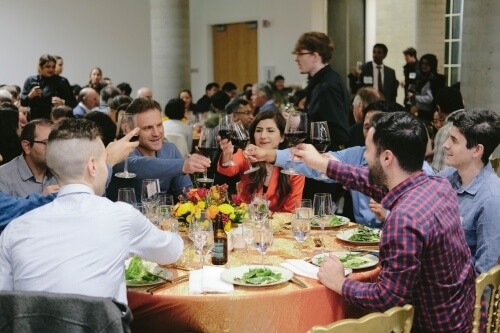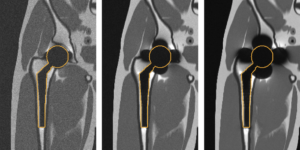
Past and present SIPI members mingled at the anniversary banquet. Alexander “Sandy” Sawchuk, second from left, spoke about the history of SIPI.
In 1972 — a time when Americans were taking pictures with Polaroids and home movies with Kodak Instamatics — a remarkable group of researchers at USC glimpsed the future. Led by alumnus William Pratt (EE M.S. ’61, Ph.D. ’65), the group established the USC Image Processing Institute (IPI) that year to solve three problems related to electronic images and videos: image coding, image restoration, and image data extraction.
Fast forward 50 years: Both the institute and the field of image processing have grown and changed considerably. IPI is now called the Signal and Image Processing Institute (SIPI) — renamed to reflect its expanded research activities — and makes its home in the Ming Hsieh Department of Electrical and Computer Engineering at the USC Viterbi School of Engineering. Cellphones have long since replaced Polaroids and Instamatics. Yet the type of image coding that the initial founders worked on remains relevant today.
“The impact is everywhere,” said Krishna S. Nayak, a professor of electrical and computer engineering and biomedical engineering who has served as SIPI director since 2018. Nayak explained that advances in image and video compression made in the institute’s earliest days laid the groundwork for everything from now-ubiquitous JPEG files to Zoom calls and modern medical imaging.
On Saturday, February 18, students and faculty from SIPI’s past and present gathered for a day of reunion and reflection to celebrate 50 years of the institute’s innovations, honor distinguished alumni and look ahead to the next half century.
A legacy of achievement
After morning tours of the campus and various USC Viterbi labs, attendees of the anniversary celebration gathered for the main program at the USC Michelson Center for Convergent Bioscience. It kicked off with a historical overview of SIPI given by Alexander “Sandy” Sawchuk, a professor emeritus of electrical and computer engineering and one of the earliest members of the institute.
Sawchuk discussed how the institute first got started and highlighted its accomplishments over the past five decades. He presented a considerable list of SIPI research results that are tangible in everyday applications including teleconferencing, streaming technology, machine learning, cloud computing and smartphones, among others.
“It’s been a remarkable 50 years,” said Sawchuk. “They’ve gone by very fast. At the time, when we started, we didn’t have any idea of how pervasive our technical results would be in life today.”
He also spoke to the values of collegiality, cooperation, respect, and teamwork that have shaped the institute and guided its success.
Nayak praised Sawchuk and the other founding members of SIPI for this collaborative foundation that’s allowed the institute to endure and thrive. “Sometimes you have this convergence of talent and mutual interest that forms institutes that become highly productive,” said Nayak. “They created this culture where we support each other.”
Notable innovations

Krishna S. Nayak (far left) and C.-C. Jay Kuo (far right), the current and former director of SIPI, respectively, speak about the institute’s research.
Over the years, the focus of SIPI researchers has broadened from image processing to multimedia signal processing. Today, the research interests of the 15 current faculty members span applications including human-centered and speech signal processing, computer vision, immersive audio, brain-computer interfaces and medical imaging.
These are underpinned by theoretical analysis and algorithm development in graph signal processing, non-convex and sparse optimization, inverse problems, machine learning and fuzzy and neural systems.
Some of the outstanding achievements by current and former SIPI faculty through the decades include:
- Transform coding, the basis for the JPEG file format, done by Pratt.
- MPEG, the moving image equivalent to JPEG in recording and transmission of video, with major innovations in fast motion search and rate control contributed by C.-C. Jay Kuo and Antonio Ortega, respectively.
- Image recognition and detection, pioneered by Harry Andrews.
- Medical imaging developments, including the “Brainstorm” software system created by Richard Leahy.
- Development of “fuzzy logic” by Bart Kosko and Jerry Mendel, a technique to avoid over-sensitive, continuous on-off controls by software always hyper-defining yes and no.
- Optical image processing and three-dimensional imaging (holography) brought forward
by Sawchuk and Andrews. - Sound reproduction, with Chris Kyriakakis developing new systems creating extraordinary fidelity by awareness of listener location.
- Advances in interpretation of images, such as the ability to recognize faces or follow images in moving video captures, pioneered by Gerard Medioni.
- The creation of a new software tool, GD-IQ, which employs machine learning to assess race and gender disparities in films and television, by Shri Narayanan in partnership with Google.org and the Geena Davis Institute.
- Advances in low-field magnetic resonance imaging (MRI) for use in medical imaging of lungs, hearts, fetuses, metallic implants and vocal production of speech, by Nayak.
Honoring esteemed alumni
Following reflections on SIPI’s innovations over the decades, attendees turned their attention to the achievements of alumni with speeches by recipients of the inaugural SIPI Distinguished Alumni Awards.
SIPI has graduated around 500 Ph.D.s over the last 50 years. The awards were established to honor USC SIPI graduates who have made professional and technical contributions that bring extraordinary distinction to themselves, the institute and USC. The awards included three categories: junior, mid-career and senior (with Ph.D. graduation years from 2012-22, 2002-11, and earlier than 2002, respectively), with distinctions in three sectors: academia, industry and government.
See the full list of recipients here: https://minghsiehece.usc.edu/groups-and-institutes-sipi-sipi-50th-anniversary-awardees/
SIPI status
After awardees made their remarks, Richard Leahy, chair of electrical and computer engineering, and Nayak offered a snapshot of current activities in SIPI and the department more broadly.
Nayak highlighted recent academic partnerships with an array of universities in the US and UK, as well as industry partnerships with Google, Siemens Healthineers, Apple and more. He noted that SIPI’s reach extends well beyond research publications to software and data sharing and the curation of reference datasets, such as tools developed in the Signal Analysis and Interpretation Laboratory (SAIL). He also provided updates on new research infrastructure, including the recent installation of a Siemens low-field MRI machine in the Dynamic Imaging Science Center (DISC).
In addition to speaking about his own low-field MRI research, Nayak shared updates on the research activities of veteran SIPI faculty, including Leahy’s brain image analysis, B. Keith Jenkins’ machine learning applications, Bart Kosko’s Bayesian bidirectional backpropogation, and Chris Kyriakakis’ archaeoacoustics.
Shaping new directions
Nayak also discussed the research of Justin P. Haldar, who is developing methods to improve existing advanced MRI technologies. Haldar is one of three SIPI faculty hired over the past decade, along with Maryam Shanechi and Mahdi Soltanolkotabi.
“Every new hire means it’s really the future direction,” said C.-C. Jay Kuo, a professor of electrical and computer engineering who served as SIPI director from 2006 to 2012. In the research interests of these three recent hires, he said, “You can see the shifting focus of the institute,” with artificial intelligence (AI) and biological signal processing surfacing as important new frontiers.
Both Shanechi and Soltanolkotabi gave presentations during the anniversary program about their current work. Shanechi is working to develop neurotechnology and brain-machine interfaces as alternative therapies for people with neurological and neuropsychiatric disorders. She and her team have developed decoders that can predict mood from intracranial human brain activity and models that can predict the effect of electrical stimulation therapy on multiregional brain activity.
Soltanolkotabi, who is the director of the center on AI Foundations for the Sciences (AIF4S), works on building novel theoretical foundations for AI and utilizing these theoretical results for scientific applications. One example is a new method for reconstructing MRI images that shows promise to significantly lower patient scan time and device cost, key factors in increasing the use of this important medical imaging technique.
The research highlights concluded with presentations by SIPI professors Shri Narayanan, Antonio Ortega, and Kuo.
A bright future

Maryam Shanechi (center) and colleagues raise their glasses to toast SIPI.
After the research presentations, the celebration adjourned for a break and reconvened in the evening. A festive cocktail hour was followed by dinner and a ceremony for the alumni award recipients.
As emeritus faculty and alumni mingled with current faculty and students, a sense of intergenerational pride in the institute was palpable.
Nayak reflected on how the future of SIPI will be shaped by the next cohort of leaders. “The institute is like a living thing that evolves over time,” he said, noting that the institute is now older than he is. “I hope that the young generation can be good stewards of what the older generation created.”
Published on February 22nd, 2023
Last updated on February 22nd, 2023












